
Lasius is a genus of formicine ants. The type species for this genus is the black garden ant, Lasius niger. Other major members, which live in drier heathland, are the cornfield ant, L. neoniger, and L. alienus. Other species include the temporary social parasites of the L. mixtus group and the hyper-social parasite Lasius fuliginosus. Lasius flavus is also a commonly seen species, building grassy hillocks in undisturbed pasture. In the Alps, these mounds – always aligned east to catch the first rays of the rising sun – have been traditionally used by goatherds as natural compasses. Species in the subgenus Acanthomyops, in particular L. interjectus and L. claviger, are commonly known as citronella ants due to their citronella-like smell.

The black garden ant, also known as the common black ant, is a formicine ant, the type species of the subgenus Lasius, which is found across Europe and in some parts of North America, South America, Asia and Australasia. The European species was split into two species; L. niger, which are found in open areas; and L. platythorax, which is found in forest habitats. It is monogynous, meaning colonies contain a single queen.
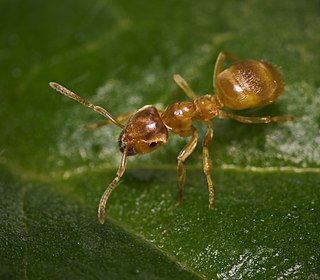
The yellow meadow ant, also known as the yellow hill ant, is a species of ant occurring in Europe, Asia, and North Africa. Populations in North America are now considered a different, related species, Lasius brevicornis.

A queen ant is an adult, reproducing female ant in an ant colony; she is usually the mother of all the other ants in that colony. Some female ants, such as the Cataglyphis, do not need to mate to produce offspring, reproducing through asexual parthenogenesis or cloning, and all of those offspring will be female. Others, like those in the genus Crematogaster, mate in a nuptial flight. Queen offspring ants among most species develop from larvae specially fed in order to become sexually mature.
Lasius murphyi is a species of ant in the genus Lasius. It is endemic to the United States and Canada.

Lasius umbratus, colloquially known as the yellow shadow ant and yellow lawn ant, is a Palearctic species of parasitic ant distributed across Eurasia and the Maghreb region of Africa. It was once thought that this species occurred in North America as well, but comparative genomic studies indicate the Afro-Eurasian and American populations are discrete and not closely related enough to represent a single species. The North American populations are now treated as a different species, Lasius aphidicola.

Lasius alienus, or cornfield ant, is a species of ant in the subfamily Formicinae. Workers have a length of about 2–4 mm, Queens are larger (7–9 mm).

Delplanqueia dilutella is a species of moth in the family Pyralidae. It was described by Michael Denis and Ignaz Schiffermüller in 1775. It is found in most of Europe, east to Russia, Turkey, Iran and Mongolia.
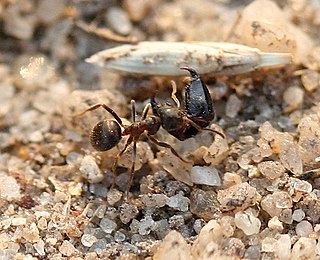
Lasius japonicus is a species of ant belonging to the genus Lasius, that are commonly found throughout East Asia. The species has been observed spraying formic acid both defensively and offensively. It is also known to tend to aphids in exchange for their honeydew secretions, and have been found to be far more attentive to their aphids then other similar ant species. In appearance they are mostly black in color with a tinge of white on their gaster.

Myrmecophilus pergandei, the eastern ant cricket, is a species of ant cricket in the family Myrmecophilidae. It is found in North America. It is a wingless cricket that is an obligate kleptoparasite of ants living in their nests. They lack both wings and tympanal organs on the front tibia.
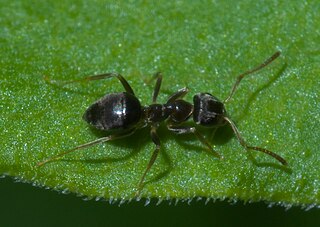
Lasiini is a tribe of ants in the family Formicidae. There are about 10 genera and more than 450 described species in Lasiini.

Lasius subumbratus is a species of ant in the family Formicidae.
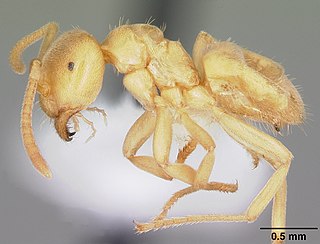
Lasius nearcticus is a species of ant in the family Formicidae.

Lasius crypticus is a species of ant in the family Formicidae.

Formica argentea is a species of ant in the family Formicidae.

Formica pergandei is a species of ant in the family Formicidae.
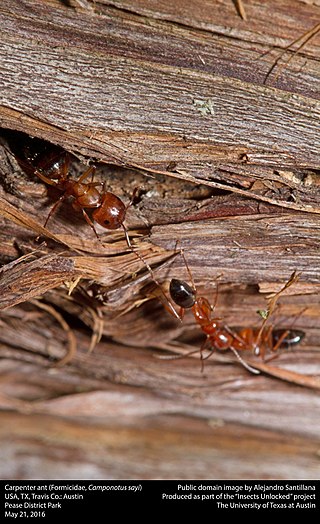
Camponotus sayi is a species of ant in the family Formicidae.

















